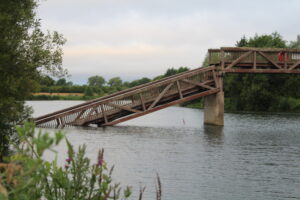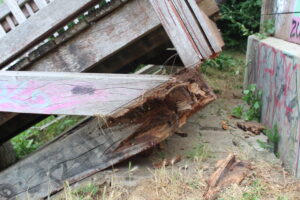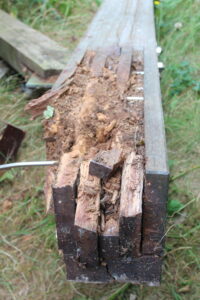Who is going to be accountable for this costly fiasco? It is not only the money – but also the reputational harm being distributed across multiple responsible authorities.
This is an image of the partially collapsed timber footbridge at Ashford Lane, Dorney, Bucks in June 2025.

Dorney Parish Council has published a (critical and demanding) status report dated June 2025 here
You will find a detailed (prior to the collapse) Ashford Lane footbridge 74 page inspection report by Bridge Station and dated June 2024 here
The Ashford Lane Footbridge 90 page report by Atkins (prior to the collapse and incorporating the Bridge Station report) is here
My view is that the visual inspections become less effective over time – to a point where they are inadequate (to be honest – actually totally useless in the specific areas where there is advanced internal rot lacking external visual indicators). There is a need for the use of readily available NDT (non-destructive testing) equipment and techniques.
You have only to look at the image below to see how internal rot was apparently overlooked during the inspection process. The combination of questionable design and construction leading to loss of strength has been exacerbated by advanced rot at a vulnerable and critical position. The vertical post and the diagonal brace are totally disconnected and displaced both longitudinally and laterally from the main beam.

Image below – rotten to the core?

I put the question to my mate Claude AI as follows: Our 20 year old timber footbridge over the river collapsed. Visual inspections failed to reveal significant rot in critical areas. What non destructive testing equipment is available for use when inspecting timber please?
Claude says the following:
Several non-destructive testing (NDT) methods are available for inspecting timber structures, particularly useful for detecting internal defects that visual inspection can miss:
Resistance Drilling/Drilling Resistance
- Equipment like the Resistograph or IML-RESI measures drilling resistance as a thin needle penetrates the wood
- Provides real-time resistance graphs showing density variations, decay, and hollow areas
- Excellent for detecting internal rot while leaving only a 1.5-3mm hole
Ultrasonic Testing
- Portable ultrasonic devices (like Sylvatest or Pundit) measure sound wave transmission through timber
- Detects internal voids, decay, and density changes
- Can assess structural integrity along the grain and perpendicular to it
Micro-drilling
- Uses very small diameter bits (1-2mm) to assess internal condition
- Provides wood chip samples for visual assessment of decay
- Minimal damage to the structure
Stress Wave Testing
- Equipment like the Fakopp or Director HM200 measures stress wave propagation
- Detects internal defects, checks bolt connections, and assesses overall structural integrity
- Can cover large areas quickly
Electrical Resistance/Moisture Meters
- Pin-type or pinless moisture meters detect high moisture content areas
- Helps identify zones prone to decay development
- Some advanced models can penetrate deeper into timber sections
Ground Penetrating Radar (GPR)
- Less common for timber but can detect large internal voids
- More typically used for foundations and buried elements
For bridge inspections, resistance drilling and ultrasonic testing are often the most practical combination, as they can assess both surface and internal conditions while providing quantitative data about structural integrity.
And what about the other timber footbridges over the Jubilee River. You can view a short video of the Black Potts footbridge problems here
END


1 thought on “Ashford Lane footbridge inspection reports”
Comments are closed.